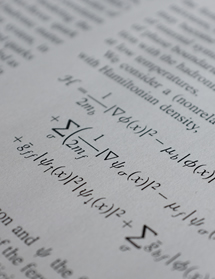- Nuclear Physics Research
- Theoretical Physics Research
- Discovery of New Elements
- Cosmological Research
- Applied Research
Theoretical Particle Physics Research
The role of Theoretical Particle Physics
Atoms, which make up molecules, consist of a nucleus (positively charged) and electrons (negatively charged) that surround it. This picture of the atom was elucidated by Hantaro Nagaoka and Ernest Rutherford about 100 years ago at the dawn of the 20th century. However, the stability of the nucleus had been a mystery until Hideki Yukawa proposed his theory of mesons in the 1930s, which explained that the nucleus was a bound state of protons and neutrons, where the latter two particles were bound by exchanging mesons. Following this pioneering research, in the 1960s Yoichiro Nambu proposed that both protons and neutrons are composite particles, consisting of three quarks along with gluons (a type of gauge particle) that bind the quarks. Around the same period, the theoretical basis for describing the microscopic world of these particles and their interactions was established by several physicists, including Shin-ichiro Tomonaga.
In the 1970s, a six-quark model was proposed by Makoto Kobayashi and Toshihide Maskawa. Since then, six types of quarks and six types of leptons (a family that includes electrons and neutrinos) have been identified, and a gauge theory based on these quarks and leptons has been established as the Standard Model of elementary particles. Furthermore, much discussion has been devoted to the possibility of string theory as a candidate for the theory of everything, which contains a graviton in addition to quarks, leptons, and other gauge particles.
In this manner, the structure of matter surrounding us has many layers. The role of physics is to elucidate this structure via collaborative work in theory and experiment. In particular, the role of theoretical physics is to study this layered structure, as well as to elucidate its logic across these multiple layers. A typical example of the former is string theory and of the latter is spontaneous symmetry breaking or phase transition that commonly exists across various layers. The quark–gluon plasma that manifests in the early universe and new matter structure such as neutron superfluid, hyperon matter, and quark matter that emerge inside neutron starts are also the target of our theoretical division’s investigations.
Exploring the mysteries of the universe and matter
 The Theoretical Physics Research Division at the Nishina Center for Accelerator-Based Science aims to explore the mysteries of the universe and matter by conducting theoretical research in the following three categories: 1) new mathematical principles that are brought about by string theory, 2) the dynamics of quarks and gluons that have strong non-linearity, and 3) various quantum phenomena where protons, neutrons, and hyperons play diverse roles.
The Theoretical Physics Research Division at the Nishina Center for Accelerator-Based Science aims to explore the mysteries of the universe and matter by conducting theoretical research in the following three categories: 1) new mathematical principles that are brought about by string theory, 2) the dynamics of quarks and gluons that have strong non-linearity, and 3) various quantum phenomena where protons, neutrons, and hyperons play diverse roles.
Related Laboratories
| Laboratory | Position | Representative |
|---|---|---|
| Quantum Hadron Physics Laboratory | Group Director | Masahiko IWASAKI |
| Strangeness Nuclear Physics Laboratory | Group Director | Emiko HIYAMA |




